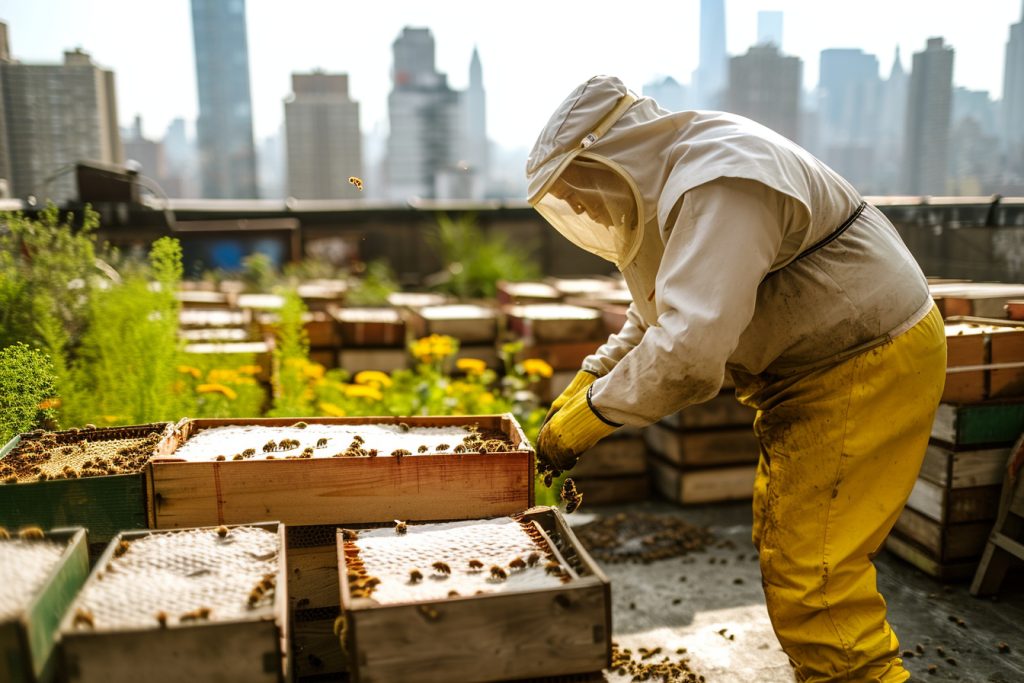Burgeoning amidst the bustling avenues and towering skyscrapers, an unexpected wave is sweeping across the urban landscape. This movement doesn’t hum with the usual honks and sirens of city life but rather with the gentle buzz of bees. Urban beekeeping has emerged as a popular trend among city dwellers seeking to reconnect with nature, support biodiversity, and even procure their own local honey. In this whimsical tale of city life intermingling with nature, we delve into the world of rooftop hives and balcony apiaries to understand the transformative power of urban beekeeping.
Urban Apiaries Unleashed: Hive High-rises!
Picture the iconic city skyline, now punctuated not just by the architectural marvels but also by the soft, harmonious hum of honeybees. These aren’t your typical high-rises; they’re hive high-rises! Urban apiaries have reclaimed rooftop real estate, offering bees a penthouse view of the city they’re helping to pollinate. The juxtaposition of hives against the backdrop of steel and glass creates a fascinating fusion of modernity and nature.
In the hands of city beekeepers, any sunny spot can become a sanctuary for these vital pollinators. From the unused corners of parking lots to the quaint gardens atop public libraries, urban apiaries are popping up in the most unexpected nooks. It’s a vertical farming trend that adds greenery and vibrancy to the concrete canvas of city life. Plus, the architectural challenge of incorporating hives into urban design has become a buzz-worthy topic among eco-conscious builders and designers.
But why stop at the visual spectacle? Urban beekeeping is quickly becoming a community-building activity, with workshops and local ‘hive tours’ strengthening neighborhood bonds. City dwellers are donning bee suits and becoming avatars of sustainability. These hive-minded citizens are not just keeping bees; they’re creating buzzing beacons of ecological hope in the heart of the city.
Bee the Change: Pollinating the Concrete Jungle!
Amid the concrete and cobblestone, urban bees are thriving, pollinating the myriad of plant life that peppers our cityscapes. They’re the unsung heroes transforming our cities into lush ecosystems, one flower at a time. With every bloom they visit, they bridge the gap between rural and urban environments, showing that even the most industrialized places can have a soft spot for biodiversity.
Urban beekeeping initiatives are vital for environmental education. They serve as living classrooms where city folks, both young and old, can learn about the importance of pollinators and the intricate workings of an ecosystem. It’s a hands-on experience that turns abstract concepts into tangible realities. After all, nothing beats the thrill of witnessing a bee’s flight from blossom to blossom while skyscrapers loom in the distance.
This buzz isn’t just about the bees but also about the broader implications for urban sustainability. As more people get involved, they start to understand the intimate connection between their lives and the natural world. They become advocates for green spaces, champions for pesticide-free zones, and most importantly, they set an example for the rest of the city. This ripple effect can turn a single hive into a mighty force for environmental change.
The era of urban beekeeping has dawned, bringing with it a refreshing reminder of nature’s resilience. By integrating apiaries into our cityscapes, we’re not just reaping the sweet rewards of local honey, but we’re also reshaping the very fabric of urban culture. As each new hive thrives atop our concrete foundations, we’re reminded that even in the steel heart of our cities, nature can buzz with life. So, let’s don our bee suits, grab our smokers, and embrace the hum of potential in our Buzzy Cityscape. Who knew that the simple act of beekeeping could be the secret ingredient to greening our urban environments and cultivating community solidarity? The bees did, that’s who!









